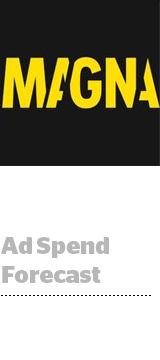
Magna’s US ad spend forecast released Wednesday paints an optimistic picture for the ad industry, following the uncertainty caused by the COVID-19 pandemic.
The IPG agency said that a quicker than anticipated economic recovery, supported by a new stimulus package, a decline in COVID rates and return to normal sporting events, will boost ad spending this year. Revenues are expected to increase 6.4% YoY to $240 billion. Digital will capture two thirds, or 67%, of total advertising sales.
The growth rate for ad spend could be as high as 8.6% when excluding the impact of the 2020 US election and the Olympics.
Magna expects most industries to ramp up spend, with travel, automotive, drinks and movies likely to see the biggest increases following heavy cuts in 2020.
The report’s author, Vincent Letang, Magna’s EVP of global market intelligence, told AdExchanger that no industry was hit harder by the pandemic than the travel industry, which is forecasted to increase its media spend by more than 20% this year as most Americans are expected to be vaccinated by the summer.
But while Letang expects further growth in 2022, he said that the U.S. Travel Association doesn’t foresee travel sales to rebound to their 2019 levels until 2025.
The report follows Magna’s global ad spend forecast in December, which determined that 2020 was not the catastrophe many had predicted, due in large part to the accelerated shift to digital during the pandemic.
In its more recent report, Magna said that net ad revenues among US media owners showed even greater resilience in 2020 and were essentially stable at $226 billion.
The ad market recovered faster than it did during the last recession of 2008, with Q4 2020 exceptionally strong due to economic stabilization, strong holiday sales and record political spending in October. While local television attracted the bulk of political spend, digital political campaign spending grew nearly threefold from 2016 to reach $1.5 billion.
Despite the pandemic, digital continued to grow by double digits in 2020, fueled by a surge in ecommerce and in digital marketing adoption by national brands and local businesses.
Digital ad sales were up by 13% overall while social and video formats grew by more than 20%. Google, Facebook and Amazon outperformed again and saw their revenues increase by 17% to reach a market share of 82%, while digital pure players also grew at 27%.
Who rebounded?
Letang said that product-based categories, such as personal care, food and pharma, rebounded faster than service-based categories ,such as restaurants and travel.
“The biggest caveat here is the auto industry, as dealerships were closed in the spring and consumers delayed major purchase decisions,” Letang said. “The pharma, personal care, food and finance categories were amongst the most resilient in 2020.”
Magna expects nine of the top 10 industries to increase their linear media spending, with the exception being retail, which will likely continue its decline “due to high debt levels and declining sales that have many retailers on the brink of bankruptcy,” he said.
Letang said that no industries increased their linear ad spend in 2020 compared to 2019, although when looking at media spend overall, the finance industry grew last year thanks to aggressive growth in digital related to a quick rebound of the stock market.
Media spend in the entertainment industry, meanwhile, was flat compared to 2019 as increased spending to advertise SVOD services offset massive declines created by closed movie theaters and delayed blockbusters.
The proliferation of AVOD platforms gives advertisers the ability to reach cord cutters, Letang said.
“It also gives advertisers the ability to diversify their spend away from YouTube and Hulu and into newer platforms, like Comcast’s Peacock,” he noted, adding that advertisers will also have to compete against the likes of Netflix, Amazon Prime and Disney Plus, which dominate viewing time.
Overall, the future is looking pretty good.
But what about how the looming identity crisis in online advertising could impact digital ad spend – or reroute it? Letang said that digital media has weathered numerous crises and that digital ad spend has outperformed Magna’s estimates every quarter.
“Only occasionally, some national brands decide to pause using ad formats or vendors altogether,” he said. “But, for the most part, the scale and opportunities are just too big to ignore and brand marketers are navigating the environment. For small businesses, these challenges are hardly on their radar at all.”






 By
By 



